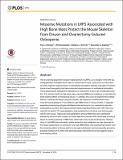| dc.contributor.author | Niziolek, Paul J. | en_US |
| dc.contributor.author | Bullock, Whitney | en_US |
| dc.contributor.author | Warman, Matthew L. | en_US |
| dc.contributor.author | Robling, Alexander G. | en_US |
| dc.date.accessioned | 2015-12-04T18:13:23Z | |
| dc.date.issued | 2015 | en_US |
| dc.identifier.citation | Niziolek, Paul J., Whitney Bullock, Matthew L. Warman, and Alexander G. Robling. 2015. “Missense Mutations in LRP5 Associated with High Bone Mass Protect the Mouse Skeleton from Disuse- and Ovariectomy-Induced Osteopenia.” PLoS ONE 10 (11): e0140775. doi:10.1371/journal.pone.0140775. http://dx.doi.org/10.1371/journal.pone.0140775. | en |
| dc.identifier.issn | 1932-6203 | en |
| dc.identifier.uri | http://nrs.harvard.edu/urn-3:HUL.InstRepos:23845173 | |
| dc.description.abstract | The low density lipoprotein receptor-related protein-5 (LRP5), a co-receptor in the Wnt signaling pathway, modulates bone mass in humans and in mice. Lrp5 knock-out mice have severely impaired responsiveness to mechanical stimulation whereas Lrp5 gain-of-function knock-in and transgenic mice have enhanced responsiveness to mechanical stimulation. Those observations highlight the importance of Lrp5 protein in bone cell mechanotransduction. It is unclear if and how high bone mass-causing (HBM) point mutations in Lrp5 alter the bone-wasting effects of mechanical disuse. To address this issue we explored the skeletal effects of mechanical disuse using two models, tail suspension and Botulinum toxin-induced muscle paralysis, in two different Lrp5 HBM knock-in mouse models. A separate experiment employing estrogen withdrawal-induced bone loss by ovariectomy was also conducted as a control. Both disuse stimuli induced significant bone loss in WT mice, but Lrp5 A214V and G171V were partially or fully protected from the bone loss that normally results from disuse. Trabecular bone parameters among HBM mice were significantly affected by disuse in both models, but these data are consistent with DEXA data showing a failure to continue growing in HBM mice, rather than a loss of pre-existing bone. Ovariectomy in Lrp5 HBM mice resulted in similar protection from catabolism as was observed for the disuse experiments. In conclusion, the Lrp5 HBM alleles offer significant protection from the resorptive effects of disuse and from estrogen withdrawal, and consequently, present a potential mechanism to mimic with pharmaceutical intervention to protect against various bone-wasting stimuli. | en |
| dc.language.iso | en_US | en |
| dc.publisher | Public Library of Science | en |
| dc.relation.isversionof | doi:10.1371/journal.pone.0140775 | en |
| dc.relation.hasversion | http://www.ncbi.nlm.nih.gov/pmc/articles/PMC4640505/pdf/ | en |
| dash.license | LAA | en_US |
| dc.title | Missense Mutations in LRP5 Associated with High Bone Mass Protect the Mouse Skeleton from Disuse- and Ovariectomy-Induced Osteopenia | en |
| dc.type | Journal Article | en_US |
| dc.description.version | Version of Record | en |
| dc.relation.journal | PLoS ONE | en |
| dash.depositing.author | Warman, Matthew L. | en_US |
| dc.date.available | 2015-12-04T18:13:23Z | |
| dc.identifier.doi | 10.1371/journal.pone.0140775 | * |
| dash.contributor.affiliated | Warman, Matthew | |


